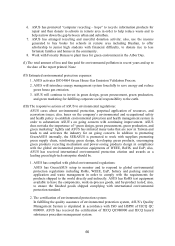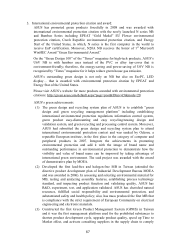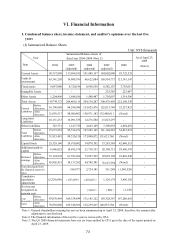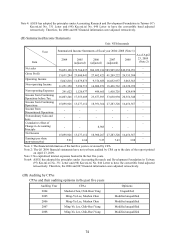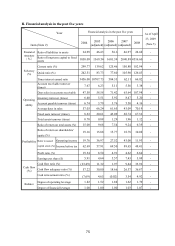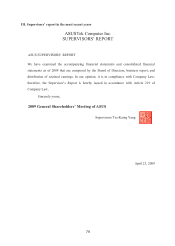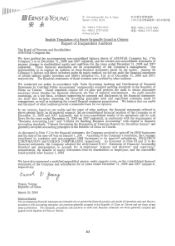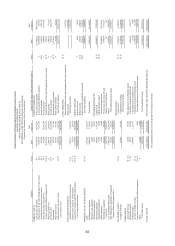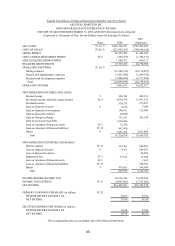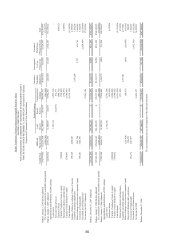Asus 2008 Annual Report Download - page 80
Download and view the complete annual report
Please find page 80 of the 2008 Asus annual report below. You can navigate through the pages in the report by either clicking on the pages listed below, or by using the keyword search tool below to find specific information within the annual report.
76
ˊˉʳ
The root causes of the financial ratio change in the last two years:
Ratio of liabilities to assets: The account payable for the procurement of raw materials is decreased in
response to the OEM business spilt to the subsidiary.
Ratio of long-term capital to fixed assets: The ratio of long-term capital to fixed assets is increased due to
the decrease of fixed assets as a result of the stock split.
Current ratio: The account payable for inventory and the procurement of raw materials is decreased in
response to the OEM business spilt to the subsidiary.
Quick ratio: The account payable for the procurement of raw materials is decreased in response to the
OEM business spilt to the subsidiary.
Times interest earned ratio: Times interest earned ratio is increased due to the decrease of CD
amortization (No interest is paid for the CB and ECB issued by the company. The amortization expense o
f
corporate bond discount is booked as interest expense without actual cash expensed in compliance with the
new requirements).!
Account receivable turnover (times): The sales income decreases due to the OEM business split to the
subsidiary. Moreover, beginning accounts receivable includes OEM business; therefore, account receivable
turnover (times) decreases.
Inventory turnover (times): The cost of goods sold decreases due to the OEM business split to the
subsidiary. Moreover, beginning inventory includes OEM business; therefore, inventory turnover (times)
decreases.
Account payable turnover (times): The cost of goods sold decreases due to the OEM business split to the
subsidiary. Moreover, beginning accounts payable includes OEM business; therefore, accounts payable
turnover (times) decreases.
Fixed assets turnover (times): The sales income decreases due to the OEM business split to the subsidiary.
Moreover, beginning fixed assets include OEM business; therefore, fixed assets turnover (times) decreases.
Total assets turnover (times): The sales income decreases due to the OEM business split to the subsidiary.
Moreover, beginning total assets include OEM business; therefore, total assets turnover (times) decreases.
Ratio of return on total assets:!The net income is decreased substantially due to the financial tsunami
occurred in the second half of the year.
Ratio of return on shareholders’ equity: The net income is decreased substantially due to the financial
tsunami occurred in the second half of the year.
Ratio of operating income to issued capital stock:!The sales income decreases due to the financial
tsunami occurred and OEM business split to the subsidiary in the second half of the year; therefore,
operating income decreases too.
Profit ratio:!The gross profit increases and income decreases due to the OEM business split to the
subsidiary that is with lower gross profit; therefore, net profit rate increases.
Cash flow ratio: The cash flow ratio increases due to the decrease of current liability and accounts
receivable as a result of OEM business split to the subsidiary.
Cash flow adequacy ratio: The cash flow adequacy ratio is increased due to the increase of net cash inflow
from operating activity as a result of a decrease of current liability and accounts receivable; also, the OEM
business split to the subsidiary.
Cash reinvestment ratio: The cash reinvestment ratio is increased due to the increase of net cash inflow
from operating activity as a result of a decrease of current liability and accounts receivable; also, the OEM
business split to the subsidiary.
Note 1: ASUS has adopted the principles under Accounting Research and Development Foundation in
Taiwan (97) Kee.mi.tzi No. 331 Letter and (98) Kee.mi.tzi No. 046 Letter to have the convertible
bond adjusted retroactively. Therefore, the 2006 and 007 financial information were adjusted
retroactively.
Note 2: The financial information is reviewed by CPA.
Note 3: Accounts receivable includes the amount of long-term accounts receivable- related party that is in
compliance with trade terms and conditions.


